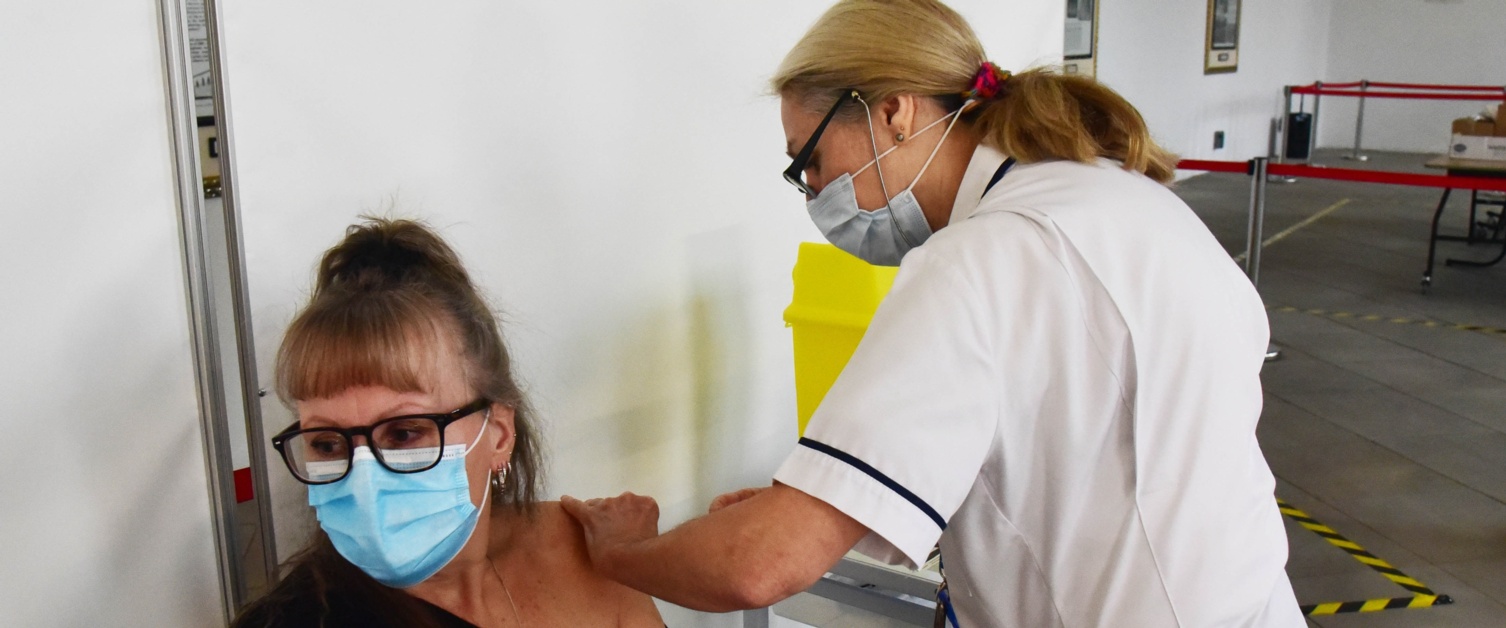Why we're vaccinating more than one group at the same time

Our target is to vaccinate all frontline health and social care staff, care home residents and staff, those aged 70+, and people who are categorised as extremely clinically vulnerable (shielders) by mid-February. These will be the first doses of the two-dose course of vaccination.
These vulnerable groups of people total around 88,000 in Swansea and Neath Port Talbot. So the good news is we’re now over a third of the way there (as of 25th January 2021.)
And with bigger supplies of vaccines now arriving, we’re picking up the pace.
Here’s a quick timeline of what’s happened so far:
- 7th December: Frontline health and social care staff vaccinations start with the first batches of the Pfizer/BioNTech vaccine. This is at our main hospitals and the Bay Field Hospital Mass Vaccination Centre or MVC.
- 5th January: The easier-to-manage Oxford/AstraZeneca vaccine arrives and Primary Care Clusters (groups of GP surgeries working together) start vaccinating in care homes
- 9th January: GPs begin vaccinating over-80s in the community
- 11th January and 21st January: Our other two Mass Vaccination Centres (MVCs) at Margam Orangery and Canolfan Gorseinon Centre open
- 20th January: Vaccinations of people aged in their 70s (starting at age 79 and working down) at our three MVCs begin
- Next: Clinically very vulnerable people will begin to get their first doses shortly, with the vast majority of the doses delivered in the community
To get through the 88,000 vaccinations as quickly as possible, we are running multiple vaccination streams within the overall programme.
We are sharing out the work, using all our local NHS resources. The health board is working in close partnership with GPs. (Later on, other primary care providers like pharmacists are likely to get involved.)
However GPs don’t have the resources to vaccinate all 88,000 people, and the mass vaccination centres run by the health board are not suitable for everyone, particularly the most vulnerable, who may often be better off having their doses in their local surgery or during a home visit.
So GPs have been given the responsibility of vaccinating in care homes, and patients on their lists who are aged 80 and over. They will also be responsible for vaccinating most of the clinically very vulnerable individuals. (Where GPs have indicated, in a small number of cases, that they cannot do this work, alternative arrangements are being put in place.)
The health board, using our MVCs and hospitals, is vaccinating the other groups of people – frontline staff and younger individuals.
Waiting for a single group like the over-80s or frontline staff, to be finished first before moving on to the next priority group, would mean some of our vaccination resources standing by unused. We must get vaccines into arms, which is why we’re twin-tracking programmes.
But it is inevitable that working this way will throw up some anomalies, like couples who are aged 80 and 79 getting their vaccinations in different places. Or some people in their 70s having their first dose before someone in their 90s.
We realise this is not as patient-centred as we would like, but working this way is the fastest way of delivering all 88,000 vaccinations at speed, so we would ask people to bear with us. GPs are working through their lists and inviting people over the age of 80 for vaccinations as quickly as they can. Now they have more generous supplies of the Oxford vaccines arriving, they are able to offer many more appointments. We estimate that GPs have already completed around half of those aged over 80’s including the majority of care home residents.
Be assured that no slot meant for someone over the age of 80 is being given to someone in their 70s. The vaccinations are just running alongside each other in different places.
There is also a much higher proportion of people aged 70+ than 80+ in Swansea and Neath Port Talbot. So even though we are vaccinating both groups together, the over-80s programme is likely to be completed very soon.
Just a bit more background about the two vaccines being used. The Pfizer vaccine is challenging to handle. It must be stored at -70C, it comes in packs of 975 doses which cannot easily be split, and it doesn’t travel well. This vaccine is only practical for use at big sessions in hospitals or mass vaccination centres, as all 975 doses must be delivered over a 4 day period or unused ones thrown away. So therefore they aren’t suitable for taking into care homes, or smaller GP clinics.
The Oxford vaccines, however, are logistically much easier to manage and more suitable to use in smaller community settings. Early on, supplies of the Oxford vaccines were less than expected, but these are now picking up, which is why GPs are now able to increase the numbers of people they can vaccinate.
Together, the three mass vaccination centres and our GPs are working as fast as they can to vaccinate these priority groups by mid-February.
After that, we’ll be moving on to the next phases, and we will keep you updated with more details when we have them:
* By spring - people with an underlying health condition. All 50-69 year olds.
* By autumn – remaining adults
We hope you find this timeline and background information useful, and that it answers some of the questions you may have.
Rydym yn croesawu gohebiaeth a galwadau ffôn yn y Gymraeg neu'r Saesneg. Atebir gohebiaeth Gymraeg yn y Gymraeg, ac ni fydd hyn yn arwain at oedi. Mae’r dudalen hon ar gael yn Gymraeg drwy bwyso’r botwm ar y dde ar frig y dudalen.
We welcome correspondence and telephone calls in Welsh or English. Welsh language correspondence will be replied to in Welsh, and this will not lead to a delay. This page is available in Welsh by clicking ‘Cymraeg’ at the top right of this page.